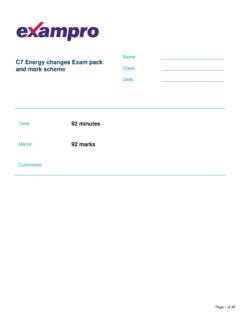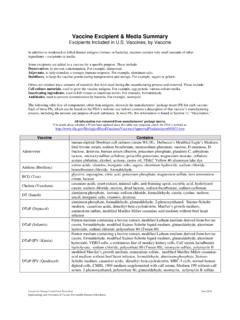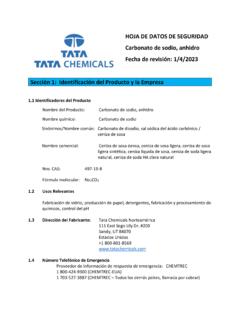Transcription of Name: C8 Rates and Equilibrium Exam - A. Hammond Biology
1 C8 Rates and Equilibrium ExamPack and Mark SchemeName:_____Class:_____Date:_____ Time:117 minutesMarks:117 marksComments: Page 1 of 46 Pieces of zinc react with dilute acid to form hydrogen graph shows how the volume of hydrogen gas produced changes with time.(a) Describe, as fully as you can, how the volume of gas produced changes with (2)1(b) A student wants to make the reaction take place suggestions are given in the ticks () next to the two suggestions that would make the reaction take place faster. Suggestions()Use bigger pieces of zinc. Use a more concentrated acid . Use zinc powder. Decrease the temperature of the acid . (2)(Total 4 marks) Page 2 of 46 Read the information and then answer the questions. Cobalt chloride paper can be used to test for paper contains anhydrous cobalt jar containing the papers must be kept closedwhen not being equation shows the reaction between anhydrous cobalt chloride and water.
2 CoCl2+6 cobaltchloride hydrated cobalt chloride(blue) (pink)(a) Choose one word from the box to complete the sentence. endothermicexothermicreversibleThe symbol means that the reaction is ..(1)2(b) Describe the colour change when water is added to the cobalt chloride (1)Page 3 of 46(c) Suggest why the jar containing the unused cobalt chloride papers must be kept (1)(Total 3 marks) Hydrogen peroxide (H2O2) contains the same elements as water (H2O).(a) Name the hazard symbol shown by using the correct word from the box. corrosive flammable oxidising toxic(1)3(b) Hydrogen peroxide decomposes in the presence of a (aq) 2H2O(l) + O2(g)(i) Complete the word equation for this chemical peroxide water + ..(1)(ii) What does a catalyst do to a chemical reaction?..(1)(Total 3 marks) Page 4 of 46(a) The figure below represents the reaction of sulfur dioxide with dioxide Sulfur trioxide(i) Complete the word equation for the reaction of sulfur dioxide with dioxide +.
3 (1)4(ii) Draw a ring around the correct answer to complete the sentence. Sulfur dioxide (SO2) isa mixture.(1)(b) The reactants are the pressure of the gases is increased, the reaction gets the the pressure of the gases is increased,the frequency of the collisions ..(1)(c) The particles need energy to the minimum amount of energy that particles need to react is calledthe .. energy.(1)(d) Give one way of increasing the rate of the reaction other than changing the (1)(Total 5 marks)Page 5 of 46 sodium thiosulfate solution reacts with hydrochloric acid . As the reaction takes place the solutionslowly turns cloudy. The diagram shows a method of measuring the rate of this reaction. A student used this method to investigate how changing the concentration of the sodiumthiosulfate solution affects the rate of this reaction. The student used different concentrations of sodium thiosulfate solution.
4 All the other variableswere kept the 6 of 46 The results are shown on the graph below. (a) (i) Draw a line of best fit on the graph.(1)(ii) Suggest two reasons why all of the points do not lie on the line of best ..2 ..(2)(b) (i) In a conclusion to the investigation the student stated that: The rate of this reaction is directly proportional to the concentration of the sodiumthiosulfate solution. How does the graph support this conclusion?..(1)Page 7 of 46(ii) Explain, in terms of particles, why the rate of reaction increases when theconcentration of sodium thiosulfate is (2)(Total 6 marks) A student does an experiment to examine the rate of reaction between magnesium and dilutehydrochloric adds 25 cm of the acid to a weighed amount of the reaction produces hydrogen + hydrochloric magnesium + hydrogen acid chloride She collects the gas and measures the volume collected at one minute the metal reacted but there was some acid left results are shown on the 8 of 46(a) The diagram shows part of the apparatus she used for the the diagram to show how the student could collect the hydrogen produced andmeasure the volume after each minute.
5 (2)(b) (i) When is the rate of reaction at its fastest?..(1)(ii) State one way in which she could increase the rate of (1)(c) (i) What is the total volume of hydrogen collected in the experiment?.. cm (1)(ii) State one way in which she could increase the final volume of hydrogen (1)(Total 6 marks) Page 9 of 46A student investigated the rate of reaction between calcium carbonate (marble chips) andhydrochloric student used the apparatus shown in Figure student: recorded the volume of gas collected every 5 seconds repeated the experiment using hydrochloric acid at different equation for the reaction is:CaCO3(s) + 2 HCl(aq) CaCl2(aq) + H2O(l) + CO2(g)7 Page 10 of 46(a) The student plotted results for the hydrochloric acid at 20 C and 40 C on a 2 shows the student s information from Figure 2 to answer these questions.(i) State one conclusion the student could make about the effect of temperature on therate of the (1)(ii) Give one reason why the student could make this (1)(iii) For the hydrochloric acid at 60 C the student had collected 30 cm3 after 15 the average rate of reaction from 0 to 15 of reaction =.
6 Cm3 per second(1)Page 11 of 46(b) The student then investigated how the surface area of marble chips affected the rate ofreaction.(i) Which two variables should the student keep constant? Tick () two boxes. Amount of water in the trough Concentration of acid Mass of marble chips Size of marble chips Volume of measuring cylinder(2)(ii) Explain, in terms of particles and collisions, the effect that increasing the surface areaof the marble chips has on the rate of (2)(c) Calcium carbonate is a catalyst for the industrial production of one reason why using a catalyst reduces (1)(Total 8 marks)Page 12 of 46A student investigated the reaction between magnesium and hydrochloric acid . The equation for the reaction is: Mg(s)magnesium+2 HCl(aq)hydrochloricacid MgCl2(aq)magnesiumchloride+H2(g)hydrogen (a) Give two observations the student could make during the ..2 ..(2)8 Page 13 of 46(b) In this question you will be assessed on using good English, organising information clearlyand using specialist terms where student investigated how the rate of this reaction changed when the concentration ofhydrochloric acid was a plan the student could your plan you should: describe how you would carry out the investigation and make it a fair test describe the measurements you would (6)(Total 8 marks)Page 14 of 46 A student investigated the rate of reaction between marble and hydrochloric student used an excess of reaction can be represented by this equation:CaCO3(s) + 2 HCl(aq) CaCl2(aq) + H2O(l) + CO2(g)The student used the apparatus shown in the student measured the mass of the flask and contents for ten results are shown on the graph.
7 Use the graph to answer the questions.(a) (i) Complete the graph by drawing a line of best fit.(1)Page 15 of 46(ii) Use the graph to find the mass of the flask and contents after grams(1)(iii) The rate of reaction can be measured by the steepness of the graph , as fully as you can, how the rate of reaction changes with time in (2)(b) The mass of the flask and contents decreased during the the equation for this reaction to help you explain (2)(c) A balance is used to measure the mass of the apparatus.(i) Which balance, A, B, or C, has the highest resolution? Balance A Balance B Balance CThe balance with the highest resolution is balance (1)Page 16 of 46(ii) The balance used for this experiment should have a high (2)(d) The student repeated the experiment using powdered marble instead of marble rate of reaction between the marble and hydrochloric acid particles was much fasterwith the (2)(Total 11 marks) Solutions A and B are colourless.
8 When they are mixed, they react and turn blue after a periodof time. A student investigated how temperature affected the rate of reaction between solutions Aand B. The rate was measured by timing how long the mixture took to turn blue. The results are shown in the table. Temperature in C2225344551 Time taken to turn blue, in seconds29025020017016010 Page 17 of 46(a) (i) Draw a graph for these results.(3)(ii) Use your graph to findhow long it takes the solution to turn blue at 40 = .. s(1)(b) (i) How does the rate of reaction change as the temperature is increased?..(1)Page 18 of 46(ii) Explain, in terms of particles, why temperature has this effect on the rate of reaction. To gain full marks in this question you should write your ideas in good them into a sensible order and use the correct scientific (3)(c) State one variable that must be kept constant to make this experiment a fair (1)(Total 9 marks) Hydrogen peroxide slowly decomposes into water and peroxide water + oxygen The reaction can be speeded up by adding manganese dioxide.
9 (a) (i) What do we call a substance that speeds up a chemical reaction without beingchanged itself?..(1)(ii) Give two other ways of increasing the rate of this ..2 ..(2)11 Page 19 of 46(b) The diagram shows how the rate of this reaction can be measured. As the hydrogen peroxide decomposes, the mass of the flask and its contents decreases. Why does this decrease in mass take place?..(1)(Total 4 marks) This item appeared in the WolverhamptonExpress and Star on October 31st, the passage and answer the questions that follow. Fumes scare atfactoryWorkers were forced to flee afactory after a chemical building was evacuatedwhen a toxic gas filled happened when nitric acidspilled on to the floor and mixedwith magnesium metal (a) The equation which represents the reaction between magnesium and nitric acid is:Mg(s) + 4 HNO3(aq) Mg(NO3)2(aq) + 2H2O(1) + 2NO2(g) Give the formula of the toxic gas that was (1)Page 20 of 46(b) Explain, in terms of particles, how the toxic gas was able to fill the factory (2)(c) The reaction of nitric acid with magnesium metal powder is more dangerous than if the acidhad fallen on to the same mass of magnesium bars.
10 Explain (1)(d) (i) Water was sprayed on to the magnesium and nitric acid to slow down the , in terms of particles, why the reaction would slow (2)(ii) Explain why it is better to add alkali, rather than just add water to the (1)(Total 7 marks) Page 21 of 46 Calcium carbonate reacts with nitric acid to produce carbon + 2 HNO3 Ca(NO3)2 + H2O + CO2 A 10 g lump of calcium carbonate was reacted with 20 cm3of dilute nitric acid . When thereaction was finished, some of the calcium carbonate was left unreacted. The graph shows thevolume of carbon dioxide made in each minute for sixteen (a) The volume of carbon dioxide made in each minute decreases until it remains steadyat 83 (2)(b) Draw a graph line, on the axes above, for an experiment where 20 cm3 of the same dilutenitric acid was reacted with 10 g of powdered calcium carbonate.(2)Page 22 of 46(c) Give one way of changing the rate of this reaction (other than using powdered calciumcarbonate).




